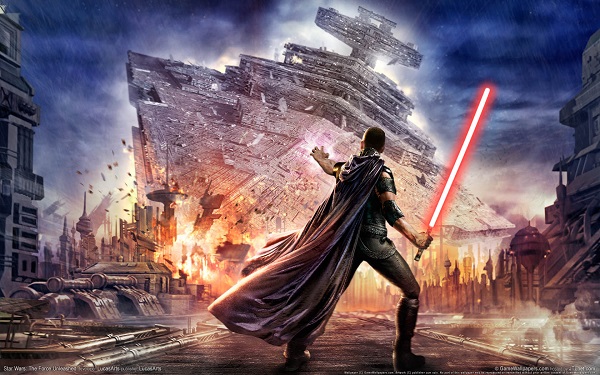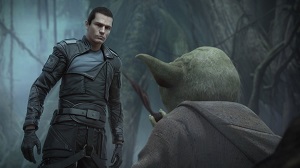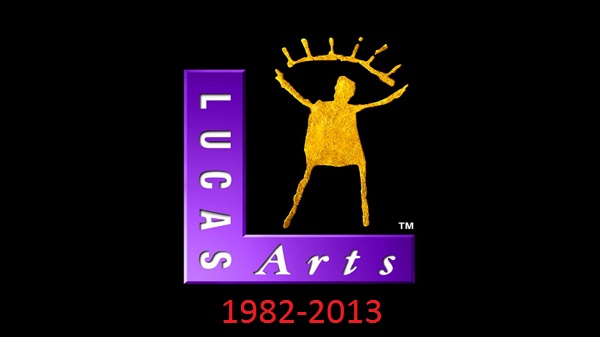Continuing our look back at the selected highs and lows of original storytelling in Star Wars games. You can find Episode One: The Golden Years HERE, and Episode Two: The Prequel Years HERE.
SPOILER ALERT – As is regularly the case in this column, we will be going into key plot spoilers for certain games. Enter at your own risk!
The release of Revenge of the Sith in 2005 marked the end of an era of Star Wars in several key respects. After six years of feverish activity and the production of a staggering amount of content – not just movies, but games, toys, EU material and all the marketing effort to sell them – it was natural that a lull would follow.
What was surprising, however, was the degree of the burnout. While hugely successful on a financial level, the Prequels had left a large proportion of the fanbase disillusioned with many feeling that things had changed with the franchise. This is especially true pertaining to the games, and LucasArts themselves for that matter. The games had become less interested in original material, mostly satisfied with adapting the Prequel films or simply not including a narrative at all, and their increasingly erratic quality had been a growing concern amongst fans, especially for a company that had previously been so admired for its consistency.
A lot of this issue was simple to explain. Many of the people who had made the great LucasArts games of the late 80s/90s had simply moved on, staff changes working in tandem with the imperative to concentrate more on straight movie tie-ins to push LucasArts in a different direction. It wasn’t the same company anymore, and it was one that simply wasn’t that interested in original Star Wars stories; if anything, the rapturous reception Bioware’s Knights of the Old Republic received only hammered home how unadventurous and stale LucasArts’s in-house games had become.
But with Star Wars burnout having reached a crescendo amongst fans, one got the impression that LucasArts were entering the post-Prequel era with little in the way of a vision for the future of Star Wars games. From here, pickings get very slim…
EPISODE THREE: THE HANGOVER YEARS (2005-2013)
2006
The only major release this year was Petroglyph’s underrated Empire at War. Its expansion Forces of Corruption (Released the same year) took a stab at narrative by chronicling the career of criminal Tyber Zann, his organization, the Zann Consortium, becoming a third faction in the game. The plot follows the usual routine of sticking to the background of the movies, but the idea of following the OT from the perspective of organized crime is a fun one, giving the game a sparkle to its metaphorical eye; one absent from its strategy precursors, Rebellion and Force Commander.
2008
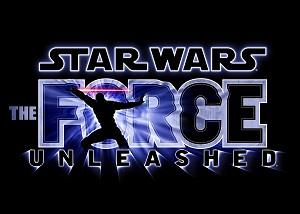 With no more movies to churn out games for (And The Clone Wars tie-in games being handled by third-party developers, and very badly at that) LucasArts decided it was time to go back to original stories, this time replicating the multimedia event model that had served them well with Shadows of the Empire. The Force Unleashed, which was released as a game, novel, comic series, sountrack and toy line, was promoted in development as a showcase for Euphoria AI engine, though as it neared release the emphasis shifted to its story.
With no more movies to churn out games for (And The Clone Wars tie-in games being handled by third-party developers, and very badly at that) LucasArts decided it was time to go back to original stories, this time replicating the multimedia event model that had served them well with Shadows of the Empire. The Force Unleashed, which was released as a game, novel, comic series, sountrack and toy line, was promoted in development as a showcase for Euphoria AI engine, though as it neared release the emphasis shifted to its story.
Ultimately, The Force Unleashed failed to make the cultural impact Shadows of the Empire did. This is mainly due to the fact that, while both games were critcized for erratic gameplay, SOTE came at a time when hunger for Star Wars was at an all-time peak, amongst fans and in the mainstream alike, and the concept of the Extended Universe still had a healthy degree of novelty value about it, not to mention a good track record in terms of quality. TFU was, unfortunately, a case of A Bit Too Much all Round. The overexposure from the prequel years was still in effect, and people were too used to subpar Star Wars games to take another one seriously.
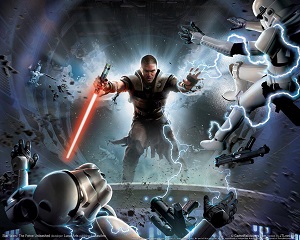 What’s more, the idea of yet another insanely powerful Force user tempted by the dark side in a story heavily hyped to change our perceptions of the OT in new and mind-blowing ways was less than appealing after six years of the Prequels offering the same thing, and not doing an incredibly good job of it to boot. While it’s cool to see the beginnings of the Rebel Alliance, and kind of cool to discover the origins of the Rebels’ winged emblem (It’s the family crest of protagonist Starkiller), it also has the same air of ‘because we can’ about it that was taken way past the point of credibility in the Prequels.
What’s more, the idea of yet another insanely powerful Force user tempted by the dark side in a story heavily hyped to change our perceptions of the OT in new and mind-blowing ways was less than appealing after six years of the Prequels offering the same thing, and not doing an incredibly good job of it to boot. While it’s cool to see the beginnings of the Rebel Alliance, and kind of cool to discover the origins of the Rebels’ winged emblem (It’s the family crest of protagonist Starkiller), it also has the same air of ‘because we can’ about it that was taken way past the point of credibility in the Prequels.
Also, while he’s well-performed by Sam Witwer (Using mocap rigs similar to those used with Andy Serkis to create Gollum in the LOTR films) there really isn’t a hell of a lot to Starkiller himself. He’s ‘adopted’ by Vader as a child and raised to be an apprentice-cum-Jedi-killing-machine, which means that any actual personality he possesses is down to Witwer as opposed to any depth of character work. He gets a love interest in the form of co-pilot Juno Six (Shades of Jan Ors in the Jedi Knight series, perhaps?) but apart from that there’s little that resonates, robbing his inner light side/dark side conflict of any real weight. For the supposed Strongest Jedi In The Galaxy This Week there’s not a lot of character there to create meaningful stakes, his exaggerated power more to do with LucasArts wanting to make a flashy game for the new consoles than anything that makes any real sense.
Besides, who wants to see some buzz-cut Mary Sue hunting Jedi when we already have Vader sitting there, who’s meant to be doing the job in the first place anyway? Isn’t that what everyone really wanted to see, what the lore had teased the fanbase with for thirty years? It’s no coincidence that the game’s most stirring moment is the prologue, which has you decimating half of Kashyyyk as Vader himself before slaying a rogue Jedi – Starkiller’s father. Naturally, after that we flash forward to take control of Starkiller as a young man, and go about spending the whole game getting back to the level of power enjoyed as Vader in those first few minutes. It’s a pretty obnoxious trope in gameplay and narrative terms and a great way to get the player to not give a shit about the drastically weakened protagonist they’re saddled with after those first few minutes of fun, doubly so when it means not getting to play as Vader anymore.
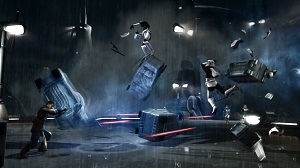 The Force Unleashed‘s story isn’t bad by any means: it just seems to take a kernel of interesting ideas (The birth of the Rebellion, Vader settling into his new identity, the already antagonistic relationship between he and the Emperor as per Sith doctrine) and shoves this half-formed character into the midst of it. The result is that it never feels like a story about Starkiller; he’s just an agent to let them throw fussy twists on the lore left and right. It all ends up feeling like fanfic much less an official part of the canon endorsed by Unca George himself, an impression that only intensified when DLC was released allowing the ‘non-canon’ Sith Starkiller to run all around the OT killing off a bunch of the major characters.
The Force Unleashed‘s story isn’t bad by any means: it just seems to take a kernel of interesting ideas (The birth of the Rebellion, Vader settling into his new identity, the already antagonistic relationship between he and the Emperor as per Sith doctrine) and shoves this half-formed character into the midst of it. The result is that it never feels like a story about Starkiller; he’s just an agent to let them throw fussy twists on the lore left and right. It all ends up feeling like fanfic much less an official part of the canon endorsed by Unca George himself, an impression that only intensified when DLC was released allowing the ‘non-canon’ Sith Starkiller to run all around the OT killing off a bunch of the major characters.
Speaking of The Chin, The Force Unleashed is also a product of his increasing insistence on exercising creative control over LucasArts product, the result rarely being positive. Game Informer’s excellent expose of the fall of Lucasarts Fall of the Empire contains several anecdotes from ex-LucasArts staff making it very clear that Lucas fostered a lot of resentment among the staff for his regular interference. He was particularly hands-on with TFU, with many of the game’s plot and design elements requiring his clearance. One anecdote from the above article, regarding the creation of the character of Starkiller, proves quite telling as to the atmosphere under which the game was created:
“(Starkiller) was only supposed to be a nickname or call sign, not a proper name…The team threw a Hail Mary to George, saying the game would have more credibility if the apprentice had a ‘Darth’ title… He threw out ‘Darth Icky’ and ‘Darth Insanius’. There was a pregnant pause in the room after that. People waiting for George to say ‘just kidding’, but it never comes, and he just moved on to another point.”
Apart from the weirdness of tone of Lucas’s response, it made no sense for him to shoot this idea down when the last three movies he made had Sith apprentices with ‘Darth’ titles. In fact, with non-affiliated Force users seeming to become increasingly out of favour in his vision of the lore, why would Starkiller not be a Darth?
But then again, it’s not like Lucas has ever been known for consistency, and this example is emblematic of TFU‘s wider problems. It was a game designed to keep a franchise in the public eye by shoehorning itself into the last non-picked to death period of Star Wars lore. In lore terms it wasn’t offensive, just a bit weak and ultimately disposable. Much like a lot of the ‘stunning’ twists on lore Lucas employed in the Prequels it feels like a whim rather than something that was always meant to be there.
2010
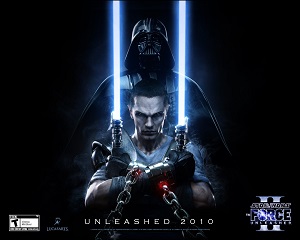 After a quiet 2009 (We could talk about The Clone Wars: Republic Heroes, but that would just be depressing for everybody) LucasArts sprung right back with The Force Unleashed II. Despite its flaws the first game was a big seller, and with the company’s fortunes on the wane it seemed inevitable that they would want to capitalize on the game’s success as soon as possible. It shows, too.
After a quiet 2009 (We could talk about The Clone Wars: Republic Heroes, but that would just be depressing for everybody) LucasArts sprung right back with The Force Unleashed II. Despite its flaws the first game was a big seller, and with the company’s fortunes on the wane it seemed inevitable that they would want to capitalize on the game’s success as soon as possible. It shows, too.
Forget the aspirations to legitimate lore the first game had: TFU II is an exercise in treading water all the way. Star Wars being Star Wars, they get around Starkiller being dead by playing the cloning card (Note to Disney: NO. MORE. FUCKING. CLONES.). It appears that Darth Vader still wants an apprentice and has been attempting to clone Starkiller, ‘your’ clone being the latest in a series of botched attempts: the clones keep going insane, haunted by visions of what turns out to be the original Starkiller’s life. Naturally, you slip out of Vader’s grasp before he can eliminate you and set out to find Juno and Kota, your former Jedi ally, and piece your/Starkiller’s life back together.
Essentially, the game’s plot is a bunch of busywork designed to a) reprise the characters from the first game and b) give Starkiller a happy – and more franchise-accommodating – ending. Boba Fett turns up to stalk Starkiller, and the game takes a ridiculous turn when you go visit Yoda on Dagobah, a sequence seemingly designed simply to evoke The Empire Strikes Back (And continue the grand Star Wars tradition of inserting important events into backstory that the characters have no plausible reason to have forgotten at the time of the movies but now have to have anyway, in this case Luke no longer being the first Jedi Yoda has trained in decades). The game was roundly trashed for the shortness of its campaign, though it’s such a lazy affair in storytelling terms that this may have been an act of mercy rather than a disadvantage. While the dialogue is solid, with Witwer again elevating proceedings with a strong performance, the story acts as simply an excuse to bring Starkiller back and renege on the finality of killing him in the first game. Considering the big song and dance about the first game’s importance to the lore and the significance of Starkiller’s sacrifice, it comes across as somewhat cheap and unimaginative. It seems that fans were unconvinced too, with the game generating toxic word of mouth and performing poorly at retail, essentially assuring the end of the franchise.
2011
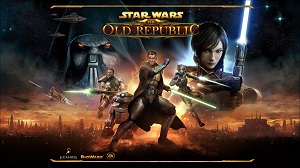 The big news in Star Wars games this year was The Old Republic, LucasArts/Bioware/EA’s massively hyped Star Wars MMO set several hundred years after the KOTOR games. Although Star Wars: Galaxies had flirted with story content, it had been a mainly crude affair that didn’t really add anything to that game’s experience. TOR, on the other hand, was created with an emphasis on story with each of the game’s classes having their own fully voice-acted plotlines with dialogue trees and player choices similar to the KOTORs. The game was commonly known to have been chosen as a continuation of the Old Republic games in lieu of a proposed KOTOR 3, the decision being made to capitalize on the MMO trend rather than adhere to the single-player design of the first games.
The big news in Star Wars games this year was The Old Republic, LucasArts/Bioware/EA’s massively hyped Star Wars MMO set several hundred years after the KOTOR games. Although Star Wars: Galaxies had flirted with story content, it had been a mainly crude affair that didn’t really add anything to that game’s experience. TOR, on the other hand, was created with an emphasis on story with each of the game’s classes having their own fully voice-acted plotlines with dialogue trees and player choices similar to the KOTORs. The game was commonly known to have been chosen as a continuation of the Old Republic games in lieu of a proposed KOTOR 3, the decision being made to capitalize on the MMO trend rather than adhere to the single-player design of the first games.
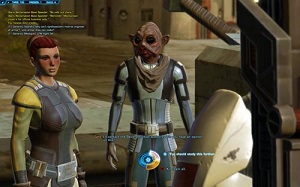 Ultimately, nothing would ever truly replace a Bioware-made KOTOR 3, but it has to be said that TOR has turned out to be a worthwhile experience in its own right. While each of the classes’ storylines are naturally slower paced due to the demands of the MMO structure, they’re actually quite fun and do a good job of exploring the Old Republic universe from a variety of angles. Of particular note are the Republic Trooper and Smuggler storylines, along with the very thriller-like Imperial Agent plot (which resumes the idea from TIE Fighter of the Imperial forces and Sith having separate agendas). Of course, we’re dealing with a much older version of the Republic/Empire and Jedi/Sith conflicts, but again, Star Wars being Star Wars, it remains pretty much analogous to the tropes laid down in the movies. You even get a few references to the original KOTORs and the fate of Darth Revan to boot, making for an experience that has a lot to offer if you can get behind the MMO gameplay.
Ultimately, nothing would ever truly replace a Bioware-made KOTOR 3, but it has to be said that TOR has turned out to be a worthwhile experience in its own right. While each of the classes’ storylines are naturally slower paced due to the demands of the MMO structure, they’re actually quite fun and do a good job of exploring the Old Republic universe from a variety of angles. Of particular note are the Republic Trooper and Smuggler storylines, along with the very thriller-like Imperial Agent plot (which resumes the idea from TIE Fighter of the Imperial forces and Sith having separate agendas). Of course, we’re dealing with a much older version of the Republic/Empire and Jedi/Sith conflicts, but again, Star Wars being Star Wars, it remains pretty much analogous to the tropes laid down in the movies. You even get a few references to the original KOTORs and the fate of Darth Revan to boot, making for an experience that has a lot to offer if you can get behind the MMO gameplay.
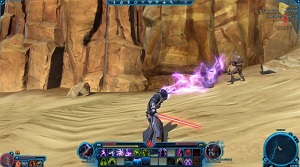 It’s testament to the quality of the writing that TOR is considered one of the more solo-play friendly MMOs out there, and could be argued to have been one of the major factors in sustaining interest during the game’s shaky first couple of years of release. It’s still not quite the same as a new KOTOR, but it provides an entertaining look at the Old Republic era from a diverse range of perspectives.
It’s testament to the quality of the writing that TOR is considered one of the more solo-play friendly MMOs out there, and could be argued to have been one of the major factors in sustaining interest during the game’s shaky first couple of years of release. It’s still not quite the same as a new KOTOR, but it provides an entertaining look at the Old Republic era from a diverse range of perspectives.
2012-2013
The Old Republic would be the last narrative-focused Star Wars game to be released under LucasArts’ watch (even in a diminished capacity). Over 2012 two titles were announced: First Assault, a downloadable online shooter that seemed to be intended to plug the gap created by the cancelled Battlefront 3, and 1313, an original narrative apparently based in and around the criminal underworld of the Star Wars universe.
 Very little exists of 1313, save concept art and a six-minute demo reel that made waves at E3 2012 showing visually spectacular Uncharted-esque gameplay. After Disney’s acquisition of Lucasfilm it was revelead that the unknown player character in the demo was a stand-in and that the game was set to star Boba Fett. Little else emerged, and in January 2013 Disney announced that they had abandoned the trademark for 1313, quashing any lingering hopes that the game would still be made.
Very little exists of 1313, save concept art and a six-minute demo reel that made waves at E3 2012 showing visually spectacular Uncharted-esque gameplay. After Disney’s acquisition of Lucasfilm it was revelead that the unknown player character in the demo was a stand-in and that the game was set to star Boba Fett. Little else emerged, and in January 2013 Disney announced that they had abandoned the trademark for 1313, quashing any lingering hopes that the game would still be made.
Three months later, Disney closed LucasArts, laying off 150 people and ending an era. Sadder than the shutdown itself was the fact that it felt like little more than a mercy killing: They had long ceased to be the company that produced so many all-time classics in the 80s and 90s, and had seen their legacy become eroded through too many mediocre games, too little creative vision and increasingly erratic management. As eagerly anticipated as 1313 was, there was little to digest past graphics and mystique (A rather apt fate for a Boba Fett game, when you think about it) and nothing that suggested that this would be anything more than just another Uncharted clone.
All in all, however, LucasArts’ use of the Star Wars property remains a cut above the norm when it comes to videogame product. There may be plenty lows, and the lows may have come more regularly in the company’s latter years, but the highlights are not just renowned as great Star Wars games, but some of the best games ever made full-stop.
The Future?
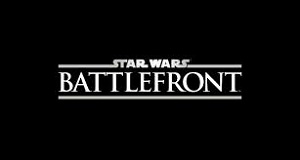 Disney have been fairly tight-lipped about future Star Wars games, though their stated wish to put added focus on mobile gaming is a concern. EA/DICE have a new Battlefront coming next year as well as an open-world game set in the universe, and there are rumblings of Bioware making another single-player Star Wars game. While I’d love to think that this is KOTOR 3, I’d imagine that EA would want to avoid any possible brand confusion with TOR. However, even if the Old Republic era isn’t used there are still periods between Episodes 4-6 and 7-9 that could be tackled. In fact, with the upcoming TV show Star Wars: Rebels set to chart the beginnings of the Rebellion you could see a Bioware RPG exploring this period more closely.
Disney have been fairly tight-lipped about future Star Wars games, though their stated wish to put added focus on mobile gaming is a concern. EA/DICE have a new Battlefront coming next year as well as an open-world game set in the universe, and there are rumblings of Bioware making another single-player Star Wars game. While I’d love to think that this is KOTOR 3, I’d imagine that EA would want to avoid any possible brand confusion with TOR. However, even if the Old Republic era isn’t used there are still periods between Episodes 4-6 and 7-9 that could be tackled. In fact, with the upcoming TV show Star Wars: Rebels set to chart the beginnings of the Rebellion you could see a Bioware RPG exploring this period more closely.
Past the above, however, the future of Star Wars games is a mystery. It’d be a fair bet to assume that games are being developed and probably aiming to release late next year to coincide with Episode VII, so we can probably expect a slew of announcements around the end of the year/early next. What is pretty much certain is that there’ll be a lot of Episode VII tie-ins with other games probably taking place post-Revenge of the Sith, but as for games telling original stories the future is less clear. The great original Star Wars games were the result of two companies – LucasArts, then Bioware – with a strong vision and a willingness to experiment, and the quality of future games will depend on developers adopting this drive. Perhaps, with Lucasfilm/Disney co-ordinating the new non-movie canon they will recognize the games’ contribution to the Star Wars lore and their part in keeping the franchise alive during its dead periods, and give us strong game narratives again. We can hope, anyway.
A New(er) Hope.
Nah, doesn’t work.
